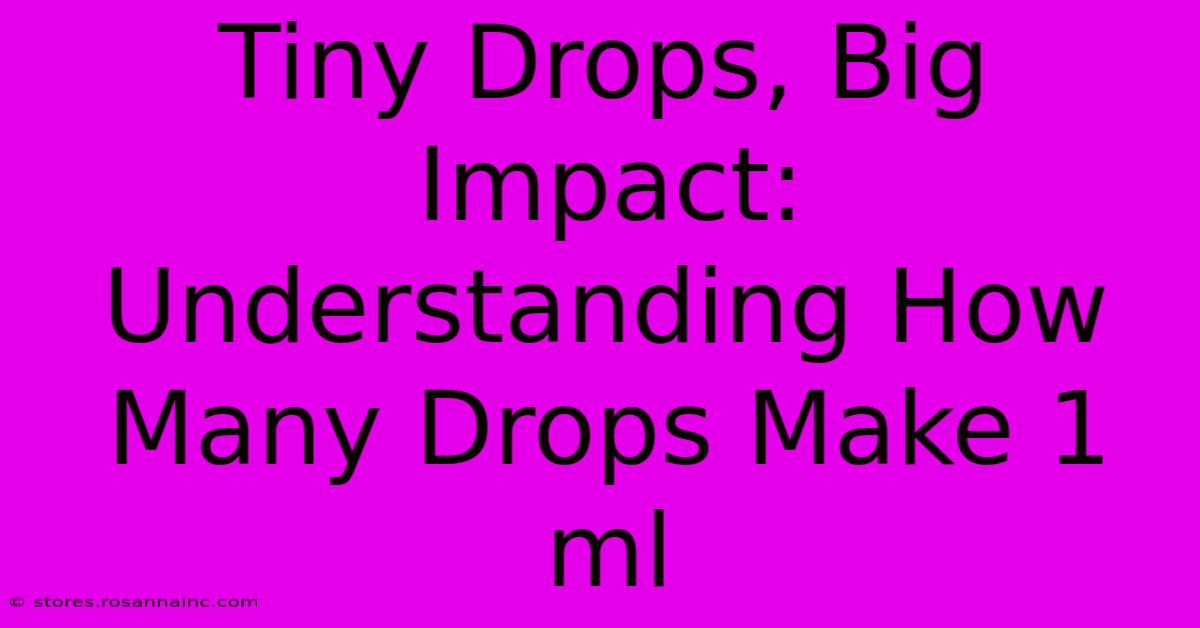Tiny Drops, Big Impact: Understanding How Many Drops Make 1 Ml

Table of Contents
Tiny Drops, Big Impact: Understanding How Many Drops Make 1 ml
Have you ever needed to measure out a precise amount of liquid, but only had a dropper? Knowing how many drops are in a milliliter (ml) can be crucial in various situations, from mixing essential oils to administering medication. The answer, however, isn't a simple number. The number of drops in 1ml is highly variable, depending on several factors. This article delves into the complexities of drop measurement and provides guidance on how to approach this common problem.
Why isn't it a fixed number?
The size of a single drop is affected by several key factors:
-
The liquid itself: The viscosity (thickness) of a liquid dramatically influences drop size. Thick liquids like honey will produce larger drops than thin liquids like water. Surface tension also plays a role; liquids with higher surface tension form smaller drops.
-
The dropper: The diameter of the dropper's tip is the most significant factor. A wider tip will release larger drops than a narrow one. Even slight variations between droppers can lead to significant differences in drop volume.
-
Temperature: Temperature can subtly affect a liquid's viscosity and surface tension, thereby impacting drop size.
-
Technique: The way you squeeze the dropper can affect the size of the drop. A gentle squeeze produces smaller drops, while a forceful squeeze will produce larger drops.
So, how many drops approximately?
While there's no universally accurate answer, a commonly used approximation is that 20 drops of water are roughly equivalent to 1 milliliter. However, this is just an estimate, and it's crucial to remember that this can vary significantly.
For other liquids, the number will differ. For example:
- Viscous liquids (e.g., honey, essential oils): Expect considerably fewer drops per milliliter. You might only get 5-10 drops per milliliter.
- Low-viscosity liquids (e.g., alcohol): You might get more than 20 drops per milliliter.
Why precision matters
In many contexts, an approximate measurement simply won't suffice. Inaccurate measurements can have serious consequences in:
- Medicine: Incorrect dosages can have harmful effects.
- Chemistry & Science: Experiments rely on precise measurements for accurate results.
- Essential oil blending: Using too much or too little of an ingredient can alter the fragrance and potential therapeutic benefits.
- Baking and cooking: Precise measurements can be the difference between a successful recipe and a culinary disaster.
The best practice: Use accurate measuring tools
The most reliable way to measure liquids accurately is to use appropriate tools:
- Graduated cylinders: These provide highly accurate volume measurements.
- Syringes: Syringes offer great precision, especially for smaller volumes.
- Pipettes: Pipettes allow for accurate transfer of specific volumes.
- Measuring spoons and cups: While less precise than the above options, they're suitable for less critical measurements.
Conclusion: Drops are not a reliable unit of measure
Relying on drops as a measurement unit is inherently imprecise. While the approximation of 20 drops per milliliter for water is a useful rule of thumb, it should not be considered accurate. For accurate measurements, always prioritize the use of calibrated tools. Understanding the limitations of drop-based measurement is crucial for accuracy and safety in various fields. Don't let tiny drops have a big negative impact; choose the right measuring tools for the job.

Thank you for visiting our website wich cover about Tiny Drops, Big Impact: Understanding How Many Drops Make 1 Ml. We hope the information provided has been useful to you. Feel free to contact us if you have any questions or need further assistance. See you next time and dont miss to bookmark.
Featured Posts
-
Beyond The Buzzer An In Depth Mavs Celtics Timeline
Feb 10, 2025
-
Kayo Sports Super Saturday On Balboa
Feb 10, 2025
-
Is Maria De Todos Los Angeles The Answer You Ve Been Seeking
Feb 10, 2025
-
The Ocean At The End Of The Lane Where Reality Ends And Wonder Begins
Feb 10, 2025
-
Nfl Super Bowl Chiefs Vs Eagles Tv
Feb 10, 2025
